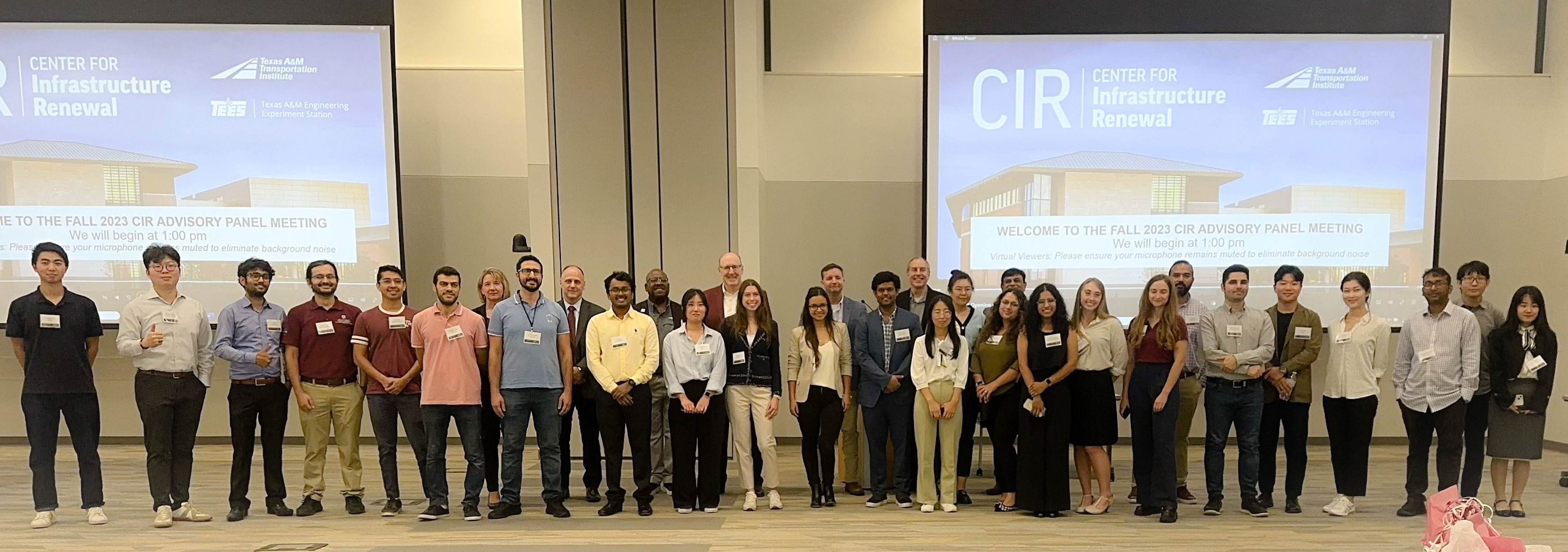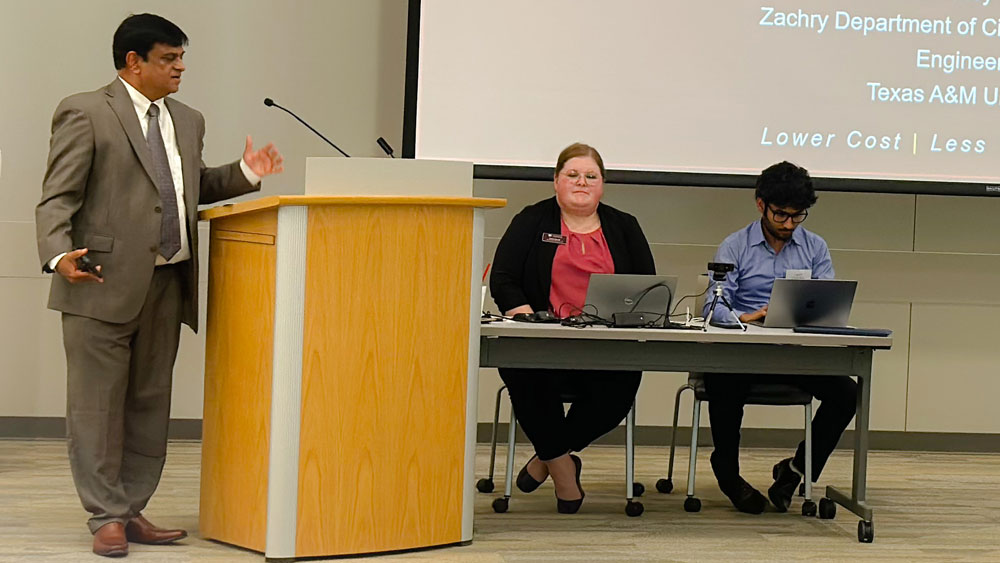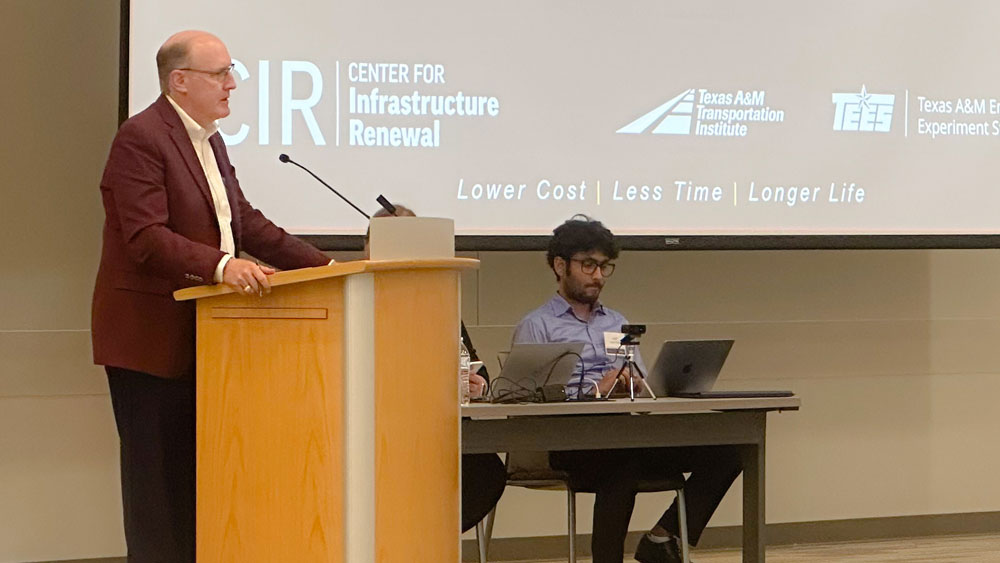
The Fall 2023 CIR Advisory Panel (CAP) meeting for the Center for Infrastructure Renewal (CIR) was held at the CIR at the Texas A&M-RELLIS campus on Friday, October 20, 2023. Before the meeting, there was a poster session highlighting the research conducted in the CIR labs. Board members and guests interacted with students and professors to learn more about their work and gain a deeper understanding of the center’s overall growth and development.
CIR Director Dr. Anand Puppala, who is also the A.P. and Florence Wiley Chair professor in the Zachry Department of Civil and Environmental Engineering at Texas A&M University, noted this poster session was the largest ever held at the CIR, featuring 26 posters and 30 students participating. This demonstrates the significant growth in human capital that the CIR has experienced in recent years.
Senior Vice President of HTNB and CAP Board Chair, John Barton ‘86, opened the meeting, followed by opening comments from Greg Winfree, agency director of the Texas A&M Transportation Institute (TTI); Dr. Rodney Bowersox, deputy director of the Texas A&M Engineering Experiment Station (TEES) and senior associate dean for research in the College of Engineering; and Lisa Akin, chief operating officer of TEES.
“[The CIR] is a tremendous asset for the state of Texas, for the agencies of TTI and TEES, but also for other agency partners and research centers here in the Texas A&M System,” Winfree said. “It’s a 21st century visioning of centers and laboratories that previously existed on main campus, but the intent here and the focus is to have a center that’s above reproach and without peer in the engineering sciences, particularly from the applied research perspective.”
Bowersox mentioned his appreciation for the infrastructure research works and collaborations at the CIR. He noted that the significant increases in funding and researchers demonstrate the quality of study performed by those housed in or utilizing the CIR. Likewise, Akin took a moment to express her appreciation for the seamless coordination between CIR staff and her department regarding the research conducted within the CIR.
Dr. Anand Puppala presented the 2023 Directors Report, highlighting exponential growth in multiple areas. Total research awards increased over 10 times from $1.53 million in 2022 to $16.05 million in 2023, thanks in part to the numerous new University Transportation Center (UTC) awards granted in March 2023.
“We are home to eight UTCs at Texas A&M. That’s a big number – no other university has that kind of number of centers on their campus – and four of those centers are housed here at the CIR,” Puppala said.
CIR Director Dr. Anand Puppala, who is also the A.P. and Florence Wiley Chair professor in the Zachry Department of Civil and Environmental Engineering at Texas A&M University, noted this poster session was the largest ever held at the CIR, featuring 26 posters and 30 students participating. This demonstrates the significant growth in human capital that the CIR has experienced in recent years.
Senior Vice President of HTNB and CAP Board Chair, John Barton ‘86, opened the meeting, followed by opening comments from Greg Winfree, agency director of the Texas A&M Transportation Institute (TTI); Dr. Rodney Bowersox, deputy director of the Texas A&M Engineering Experiment Station (TEES) and senior associate dean for research in the College of Engineering; and Lisa Akin, chief operating officer of TEES.
“[The CIR] is a tremendous asset for the state of Texas, for the agencies of TTI and TEES, but also for other agency partners and research centers here in the Texas A&M System,” Winfree said. “It’s a 21st century visioning of centers and laboratories that previously existed on main campus, but the intent here and the focus is to have a center that’s above reproach and without peer in the engineering sciences, particularly from the applied research perspective.”
Bowersox mentioned his appreciation for the infrastructure research works and collaborations at the CIR. He noted that the significant increases in funding and researchers demonstrate the quality of study performed by those housed in or utilizing the CIR. Likewise, Akin took a moment to express her appreciation for the seamless coordination between CIR staff and her department regarding the research conducted within the CIR.
Dr. Anand Puppala presented the 2023 Directors Report, highlighting exponential growth in multiple areas. Total research awards increased over 10 times from $1.53 million in 2022 to $16.05 million in 2023, thanks in part to the numerous new University Transportation Center (UTC) awards granted in March 2023.
“We are home to eight UTCs at Texas A&M. That’s a big number – no other university has that kind of number of centers on their campus – and four of those centers are housed here at the CIR,” Puppala said.

He noted the amount of faculty, staff and students housed in or utilizing the CIR facilities has also increased, raising the demand for research space within the labs. As of October 2023, the CIR has over 110 students and over 30 researchers using the facilities – triple the amount from when the center opened in 2018. Puppala expressed his gratitude and thanks to both TEES and TTI for their continued support of the CIR.
Dr. Edith Arambula-Mercado, CIR deputy director and research engineer at TTI, presented the CIR strategic plan metrics and the center’s status for each as of fiscal year 2023. The strategic plan is the center’s guidebook of goals and objectives from 2021 to 2026 and is broken down into four elements: partnerships, human capital, facilities and equipment and training and technology transfer. She noted many of these metrics have been achieved as of FY 2023.
For example, the amount of industry partnerships (partnership metric 2) has exceeded the goal of three, and the number of partners using CIR services for testing or proving technology or products (partnerships metric 4) has well exceeded the goal of 10, so much so that is has become difficult to track. Arambula-Mercado noted the CIR still has much growth potential in the training and technology transfer metrics, but many of the CIR researchers are working towards these goals specifically.
Dr. Yong-Rak Kim, a professor in the Zachry Department of Civil and Environmental Engineering, presented some of the research being done by his group at the CIR.
“I am very pleased to be here today as one of the very fortunate beneficiaries of the CIR facilities and research conducted here,” Kim said.
He had the opportunity to showcase a few of his group’s research projects on materials and their sustainability, demonstrating the practicality and functionalism of the research for real-world applications.
Dr. Edith Arambula-Mercado, CIR deputy director and research engineer at TTI, presented the CIR strategic plan metrics and the center’s status for each as of fiscal year 2023. The strategic plan is the center’s guidebook of goals and objectives from 2021 to 2026 and is broken down into four elements: partnerships, human capital, facilities and equipment and training and technology transfer. She noted many of these metrics have been achieved as of FY 2023.
For example, the amount of industry partnerships (partnership metric 2) has exceeded the goal of three, and the number of partners using CIR services for testing or proving technology or products (partnerships metric 4) has well exceeded the goal of 10, so much so that is has become difficult to track. Arambula-Mercado noted the CIR still has much growth potential in the training and technology transfer metrics, but many of the CIR researchers are working towards these goals specifically.
Dr. Yong-Rak Kim, a professor in the Zachry Department of Civil and Environmental Engineering, presented some of the research being done by his group at the CIR.
“I am very pleased to be here today as one of the very fortunate beneficiaries of the CIR facilities and research conducted here,” Kim said.
He had the opportunity to showcase a few of his group’s research projects on materials and their sustainability, demonstrating the practicality and functionalism of the research for real-world applications.

For the final segment of the meeting, John Barton introduced to the newest member of the CIR Advisory Panel, Lance Simmons, P.E., who serves as chief engineer responsible for the management and control of the Engineering and Safety Operations and District Operations at the Texas Department of Transportation (TxDOT). A roundtable discussion followed on roadway safety and driver responsibility, artificial intelligence and its growing role in multiple modes of transportation infrastructure and cost sharing.
Barton noted the need for greater safety on Texas Roadways and mentioned that “safety is paramount for all modes of transportation, and infrastructure plays a significant role in that.” Mr. Simmons agreed with this sentiment, noting the importance of transportation infrastructure safety to accompany the increasing demands for better roadways and infrastructure. He expressed his appreciation for the research done at CIR facilities, which helps in addressing TxDOT’s needs for maintaining robust and resilient infrastructure, and mentioned his plans to explore ways to work with UTCs established at CIR.
As the roundtable discussion ended, Barton took a moment to share his appreciation for the CIR and his time serving as the CIR Advisory Panel Board Chair.
“It has been a privilege and tremendous honor, and I am thrilled to have been a part of this organization and want to thank you for all that you do as researchers and staff members to make this such a wonderful place that I am passionate about,” he said.
This was Barton’s last CAP meeting as board chair, and the floor was opened for nominations. Greg Baker was nominated for the board chair position, and an official vote will be held via email to include all panel members.
To view the directory of all current CAP members, click here.
Barton noted the need for greater safety on Texas Roadways and mentioned that “safety is paramount for all modes of transportation, and infrastructure plays a significant role in that.” Mr. Simmons agreed with this sentiment, noting the importance of transportation infrastructure safety to accompany the increasing demands for better roadways and infrastructure. He expressed his appreciation for the research done at CIR facilities, which helps in addressing TxDOT’s needs for maintaining robust and resilient infrastructure, and mentioned his plans to explore ways to work with UTCs established at CIR.
As the roundtable discussion ended, Barton took a moment to share his appreciation for the CIR and his time serving as the CIR Advisory Panel Board Chair.
“It has been a privilege and tremendous honor, and I am thrilled to have been a part of this organization and want to thank you for all that you do as researchers and staff members to make this such a wonderful place that I am passionate about,” he said.
This was Barton’s last CAP meeting as board chair, and the floor was opened for nominations. Greg Baker was nominated for the board chair position, and an official vote will be held via email to include all panel members.
To view the directory of all current CAP members, click here.
